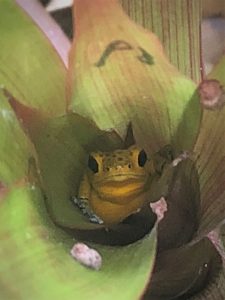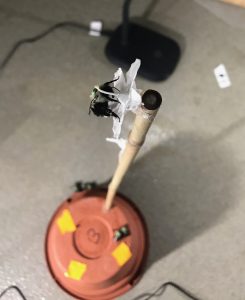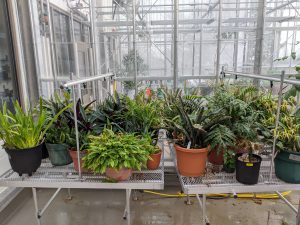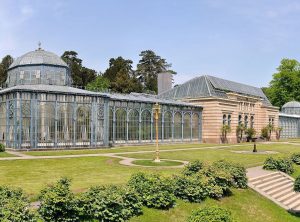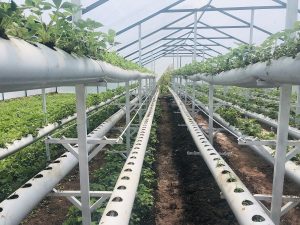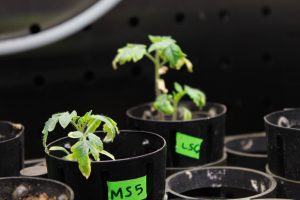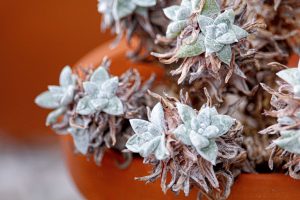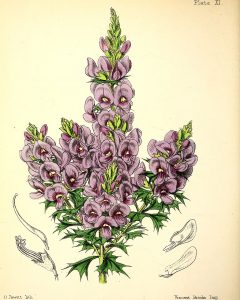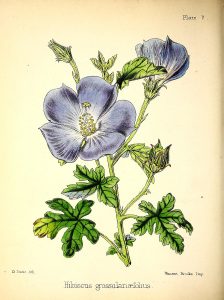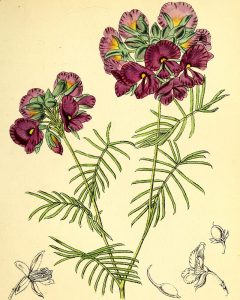What is a Research Greenhouse?
Greenhouses have played an important role in scientific research for centuries. Scroll down to learn more about the history and future of greenhouse research, or click the links below to find out about research projects happening in our very own Williams Hall Greenhouse!
Bromeliads & Poison Dart Frogs
Back to the Roots: The Purpose of a Research Greenhouse
Imagine you’re on a research expedition to the cloud forest of Costa Rica. As you descend a mountain on your last day in the field, something catches your eye: a beautiful plant. It reminds you of plants you’ve seen before, but there’s something different about it…if only it were in flower, you could really tell. But your plane leaves tomorrow–you can’t come back and check. What will you do?
You could follow the lead of hundreds of botanists before you: take the plant home with you, and put it in a greenhouse! Once planted, you’ll be able to observe the plant as it goes through all of its life stages. Who knows, you might even discover that it’s a new species.
While greenhouses have taken many different forms over time, they maintain a unique trait: they allow us to control the environmental climate. We can make it as arid as the desert or as humid as the rainforest. Researchers can even trick plants into thinking it’s spring while in the dead of winter. This unique capability allows us to use greenhouses for so much more than agriculture and horticulture. They’ve been important parts of research for hundreds of years. In fact, greenhouses can be traced back to the Romans; the greenhouses of emperor Tiberius were likely growing melons in the first century CE.1 Later in Europe, greenhouses took the shape of structures to protect smaller gardens and allow subtropical plants to survive through winter. Some of these plants included orange trees, leading to the development of orangeries. These were large greenhouse-like buildings containing ornamental fruit trees. The orangeries gave way to monumental iron and glass structures in the Victorian era such as the Crystal Palace in London built-in 1851.2
According to the Smithsonian, research greenhouses have 6 main goals: identification, preservation, chemical and genetic analysis, documentation of biological processes, scientific illustration, and photography.3 Not only can you bring plants into the greenhouse to better observe and identify species, you can use tissue samples to run genetic tests–almost like 23 and Me for plants. You can observe the plant through the seasons and write about everything you see to understand more about how the plant lives and develops. Scientific illustration and photography are important, too. We need accurate pictures of the species we know to learn from, and to share the beauty of our plants with the world!
The Fruits of Our Work: Current Contributions of Greenhouses
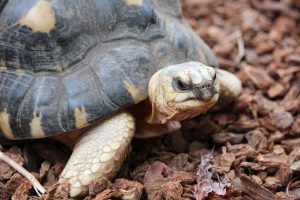
Research greenhouses today are involved in everything from conserving species to feeding the world. Due to the interconnectedness of modern society, researchers are able to keep online databases of their greenhouse species so that others can request information or access to the plants themselves for their own research.3 It’s also possible to grow and study plants that are currently threatened with extinction. Some greenhouses are also home to endangered animal species that rely on those plants. Working to maintain and study endangered species outside of their native habitat is known as ex situ conservation and is a major goal of many research greenhouses today.
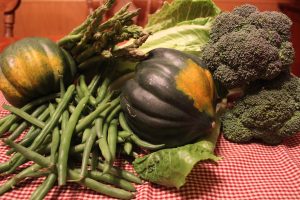
Of course, we also grow plants because we need them for food. Research greenhouses have made innumerable contributions to the efforts of increasing production efficiency and reducing food scarcity across the world. According to Cornell’s research lab, it is possible to produce 20 to 50 times more lettuce in a greenhouse than in a field of the same size!4 Researchers are constantly working to develop new ways to increase yield and quality. Many researchers study how different pollinators affect both crop quality and quantity. Over the years, they’ve found that certain pollinators, like the common eastern bumblebee (Bombus impatiens), are more effective than others and using them can lead to higher quality crops.5,6 All of this research is conducted in greenhouses, where the pollinators can be contained and observed more efficiently.
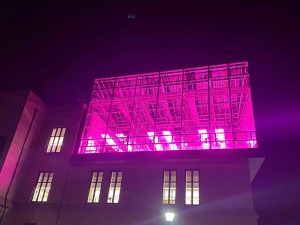
Despite all these benefits, not everything is perfectly sunny. The methods that produce the most food also tend to be more costly, not to mention the carbon footprint caused by necessary lighting. But researchers are working to fix this too, using urban models that take advantage of more efficient water systems, create local jobs, and decrease the distance of shipping to markets as well as developing more efficient lighting systems.4 You can learn more about the efficiency of our own greenhouse here!
Growing Further: The Future of Greenhouse Research
Greenhouses all over are doing amazing research, but did you know there are people conducting greenhouse research in space? A lot of plant research is actually conducted on the International Space Station (ISS). Like in our own greenhouse, the ISS has growth chambers in which they do much of their research. One growth chamber, called the Veggie, is mainly used to grow crops like lettuce, spinach, tomatoes, and peppers. The Veggie is also used to study how plants respond to microgravity and light, interactions between plants and human microbes, and how being around plants can affect human psychological health. The other growth chamber, the Advanced Plant Habitat (APH), is mainly used for larger plants. The APH is highly customizable, researchers are able to manipulate light, water nutrients, atmosphere and temperature, which allows them to study a variety of questions using this chamber.7 As you can see, greenhouses can exist in pretty much any climate, even space!
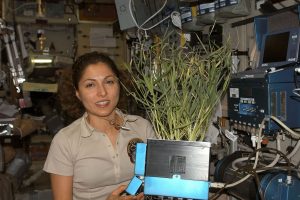
Scientists back on Earth are working to bring greenhouse research into the future as well. Researchers in Canada are working to identify a generalist biocontrol agent–an insect that would eat all the other pesky arthropods pests, without hurting the plants themselves. They’ve also developed artificially intelligent machines that can identify when plants need to be watered and do so. These robots can tell exactly how much moisture is in the soil, helping to increase water efficiency by only watering when necessary. And those aren’t the only robotic gardeners in town: researchers are also piloting robots capable of harvesting cucumbers, further reducing labor costs.8
Whether you’re interested in exotic plants, endangered species, or research in space, greenhouses continue to make important contributions to science and society. With new technology constantly evolving, the possibilities are endless. Don’t forget to click the links at the top of the page to learn more about the exciting research happening right here at The College of Wooster’s own William’s Hall Greenhouse!
M. A., A.O.J. and H.R.J.P. made this webpage to increase plant appreciation as part of Wooster’s Field Botany course in Spring 2020.
Works Cited
-
Paris, H. S., & Janick, J. (2008). What the Roman emperor Tiberius grew in his greenhouses (M. Pitrat, Ed.).
- Norton, B. (1992). Greenhouses. In B. Norton (Ed.), Solar Energy Thermal Technology. Springer. https://doi.org/10.1007/978-1-4471-1742-1_13
- Krupnick, G. A. (2012). Planted evidence found in research greenhouse. The Plant Press, 15(4)
- Chang, A. Growing the world’s food in greenhouses. Cornell Research.
- Shipp, J. L., Whitfield, G. H., & Papadopoulos, A. P. (1994). Effectiveness of the bumble bee, Bombus impatiens Cr. (Hymenoptera: Apidae), as a pollinator of greenhouse sweet pepper. Scientia Horticulturae, 57(1–2), 29–39. https://doi.org/10.1016/0304-4238(94)90032-9
- Whittington, R., & Winston, M. L. (2004). Comparison and Examination of Bombus occidentalis and Bombus impatiens (Hymenoptera: Apidae) in Tomato Greenhouses. JOURNAL OF ECONOMIC ENTOMOLOGY, 97(4), 6.
- Massa, G. D., Wheeler, R. M., Morrow, R. C., & Levine, H. G. (2016). Growth chambers on the International Space Station for large plants. Acta Horticulturae, 1134, 215–222. https://doi.org/10.17660/ActaHortic.2016.1134.29
- Sparks, B. (2019). How Canada is taking greenhouse research to the next level. Greenhouse Grower.
Picture Credits
Avetisyan, N. (2019). “Organic Strawberry House.” Retrieved from: https://commons.wikimedia.org/wiki/File:Organic_Strawberry_Greenhouse_in_Byurakan,_Armenia_03.jpg
Catlow, A. (1857). Popular Greenhouse Botany. London: John Edward Taylor.
Quartl. (2011). “Whilhema Maurisches Landhaus.” retrieved from: https://commons.wikimedia.org/wiki/File:Wilhelma_Maurisches_Landhaus_qtl1.jpg
NASA. (2006, September). Spaceflight participant Anousheh Ansari holds a grass plant grown in the Zvezda Service Module of the International Space Station [digital image]. Retrieved from https://commons.wikimedia.org/wiki/File:Anousheh_Ansari_in_the_ISS.jpg
